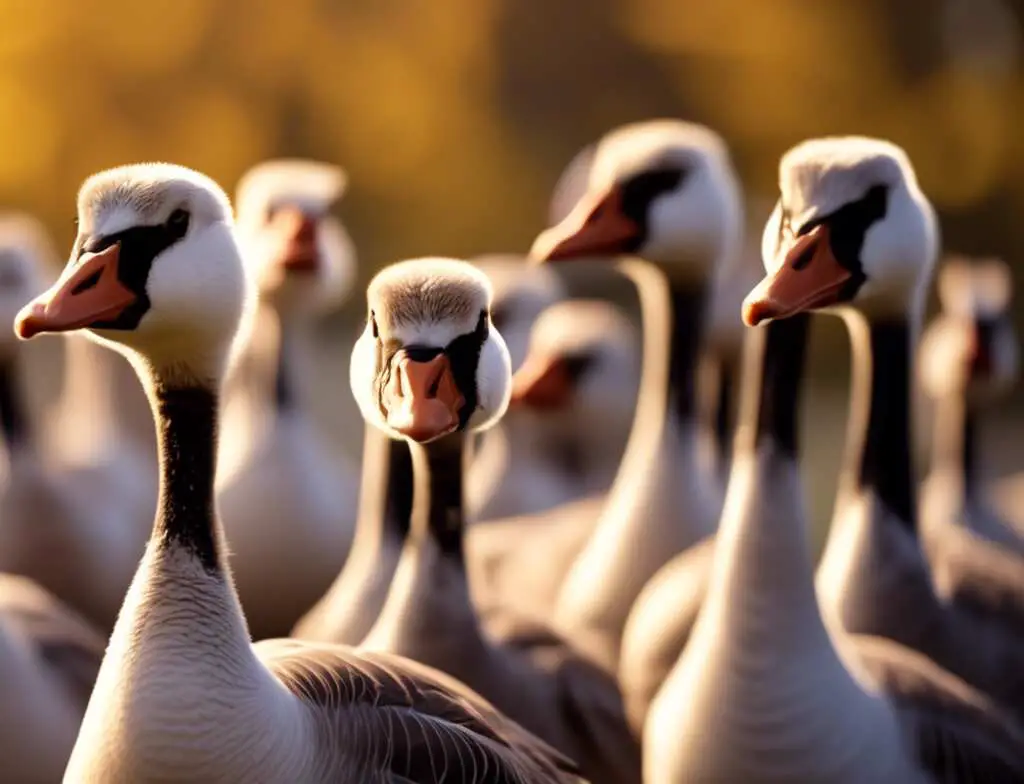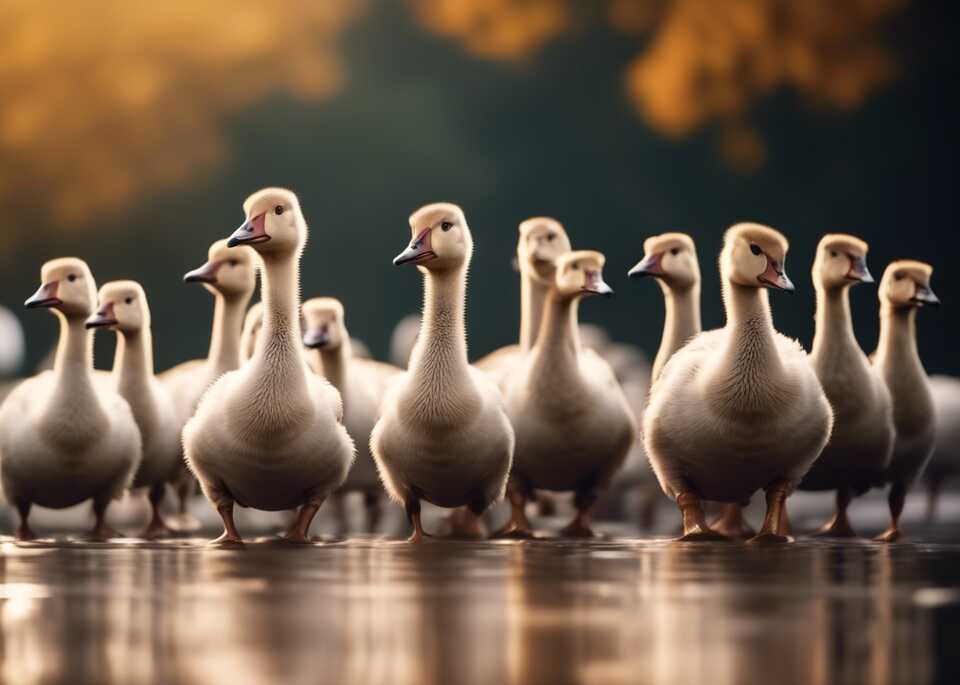Geese are fascinating creatures that are often seen flying in a V-formation across the sky. Their majestic flight and distinct honking sound capture the attention of many onlookers. However, beyond their aerial displays, geese are also known for their strong sense of community and the way they gather in groups. Have you ever wondered what a group of geese is called? Let’s delve into this interesting aspect of these remarkable birds.
Table of Contents
What Is a Group of Geese Called?
The Significance of Terminology
Understanding the terminology used to describe groups of animals not only adds to our knowledge but also reflects the rich tapestry of language associated with the natural world. From a gaggle of geese to a murder of crows, these collective nouns provide insight into how humans have observed and interacted with animals over the centuries.
A Gaggle of Geese
When geese come together in a group, whether on land or in the water, they are referred to as a “gaggle.” This term is commonly used to describe a cluster of geese interacting with one another. Within a gaggle, geese communicate through various vocalizations and body language, displaying their social bonds and hierarchical structures.
Geese in Flight
While a group of geese on the ground is called a gaggle, when these birds take to the sky, they form what is known as a “skein” or a “plump.” The sight of a skein of geese flying in their characteristic V-formation is not only mesmerizing but also serves a practical purpose. This formation reduces air resistance and helps the geese conserve energy during their long migrations.
The Venerable V-Formation
The V-formation that geese adopt during flight is a marvel of aerodynamic efficiency and cooperative behavior. By flying in this manner, geese reduce drag and increase overall efficiency, allowing them to cover vast distances with minimal effort. Furthermore, the V-formation enables geese to maintain visual contact with one another, communicate effectively, and reinforce their sense of belonging to a cohesive group.
Geese as Social Beings
Geese are highly social birds that form strong bonds with their flock mates. Whether they are foraging for food, nesting, or migrating, geese rely on their group dynamics to ensure their collective well-being. By understanding the behavior of geese in their natural habitat, we gain valuable insights into the importance of community, communication, and collaboration.
A group of geese is called a “gaggle” when they are on the ground and a “skein” or a “plump” when they are in flight. The terminology associated with these avian gatherings highlights the intricate social structures and behaviors of geese. By appreciating the significance of these collective nouns, we not only enrich our vocabulary but also deepen our connection to the natural world. Next time you see a group of geese, you’ll have a greater understanding of the bonds that unite these remarkable birds.
Fascinating Collective Nouns: Unveiling the Terminology of Animal Groups
Collective nouns, or terms that refer to groups of animals, are a fascinating aspect of the English language. These specialized terminologies often paint vivid images of nature and evoke curiosity about different species. One such intriguing collective noun is used to describe a group of geese. So, what exactly is a group of geese called?
Unveiling the Mystery: What is a Group of Geese Called?
A group of geese is commonly referred to as a “gaggle.” The term “gaggle” not only describes a group of geese but also highlights their social nature and communal behavior. Geese are known for their strong family bonds and loyalty to their flock, making the term “gaggle” a fitting and endearing descriptor for these birds.
The Social Dynamics of Geese
Geese are highly social creatures that prefer to stay in groups for various reasons, including safety, companionship, and efficient foraging. In a gaggle, geese work together to protect each other from predators, navigate during migration, and communicate effectively through honking sounds. This collective behavior showcases the intricate social dynamics within a group of geese.
Interesting Facts About Geese and Their Gaggles
- Leadership Roles: Within a gaggle of geese, a leader often emerges to guide the flock during migration. This leader sets the pace and ensures that all geese stay organized and on course.
- Formation Flying: Geese are known for their iconic V-shaped flight formation, which helps reduce air resistance and enables them to conserve energy during long flights. This formation also promotes communication among the geese in the group.
- Migratory Patterns: Many species of geese undertake long-distance migrations, traveling thousands of miles to reach their breeding or wintering grounds. The collective strength of a gaggle aids geese in navigating these arduous journeys.
Symbolism and Cultural Significance
Beyond their biological characteristics, geese and their gaggles hold symbolic meanings in various cultures around the world. In some traditions, geese represent loyalty, courage, and teamwork, reflecting the qualities observed in these birds’ social structures. Additionally, geese appear in folklore, mythology, and art, further emphasizing their significance in human society.
Conservation and Protection Efforts
Despite their resilience and adaptability, geese face challenges in the modern world, including habitat loss, pollution, and climate change. Conservation efforts play a crucial role in safeguarding geese populations and preserving their natural habitats. By understanding the importance of gaggles and their ecological roles, conservationists work to ensure a sustainable future for these remarkable birds.
The next time you spot a group of geese gracefully moving across the sky or gliding on a serene lake, take a moment to appreciate the collective synergy of their gaggle. These birds exemplify the power of unity, cooperation, and togetherness—an inspiring lesson from the natural world.
Conclusion
Understanding the unique terminology used to describe groups of animals adds a layer of depth to our interactions with the natural world. From a gaggle of geese to a pod of whales, these collective nouns shed light on the social dynamics and behaviors of these creatures. By delving into the intricacies of these terms, we gain a richer understanding of the interconnectedness of animal communities and the way they function together.
The concept of collective nouns is not only informative but also fascinating. It provides insight into the historical and cultural influences that have shaped the English language. These terms have evolved over centuries, reflecting the observations and perceptions of various societies towards different animal groupings. By exploring the origins of these collective nouns, we can unravel a tapestry of human-animal relationships and the significance attributed to these creatures in our collective consciousness.
Moreover, knowing what a group of geese is called is more than just an interesting piece of trivia. It serves as a reminder of the importance of language in shaping our understanding of the natural world. By assigning specific terms to different animal groups, we acknowledge the diversity and complexity of life on Earth. This awareness can foster a sense of respect and appreciation for the interconnected ecosystem in which we all exist.
The exploration of collective nouns offers a glimpse into the rich tapestry of language and the intricate relationships between humans and the animal kingdom. By unraveling the mystery of what a group of geese is called, we embark on a journey of discovery that transcends mere words. It opens a gateway to a deeper appreciation of nature’s wonders and the interconnected web of life that binds us all together.
So, the next time you encounter a flock of geese gracefully flying overhead, remember the collective noun that unites them – a gaggle. This small piece of knowledge encapsulates a world of wisdom about the beauty and complexity of the natural world around us.



